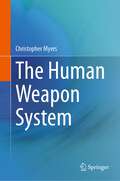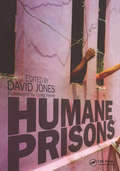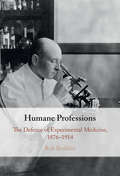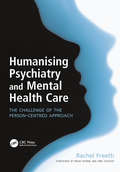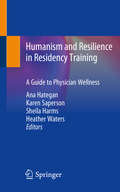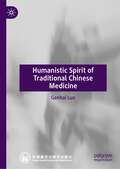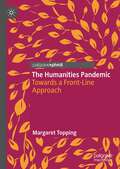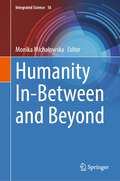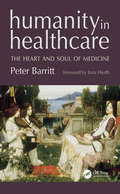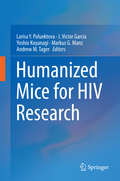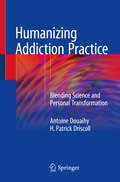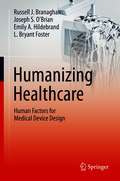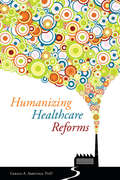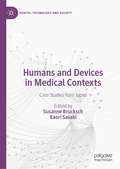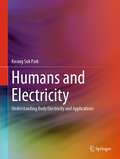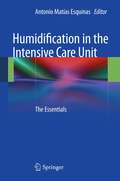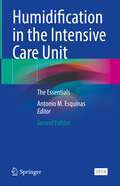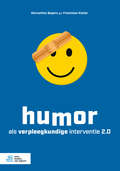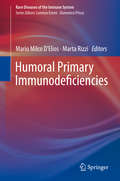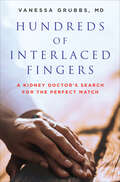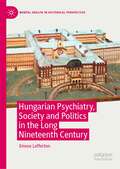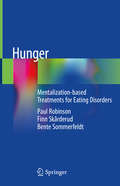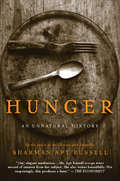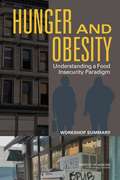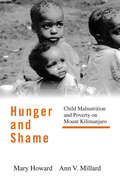- Table View
- List View
The Human Weapon System
by Christopher MyersThis book discusses the differences between a human weapon system and a tactical athlete and what a human optimization program is. Furthermore, this book discusses and demonstrates how to put together a training program at an organizational level for the human weapon system. A systematic approach is presented and discussed, from initial analysis of the human weapon system to creating a multi-domain human performance optimization program. This book strives to familiarize the reader with the systematic approach that the author has utilized as an exercise physiologist in the Department of Defence over the past ten years. This book also explains how to utilize technology to individualize the human performance optimization program at an organizational level. The book discusses current technologies in power generation, measuring endurance, and nutrition, and also demonstrates to strength coaches and practitioners how to use these technologies and individualize optimization.
Humane Prisons
by David JonesBased on the popular courses run by the Centre for Evidence-Based Medicine in Oxford, and written by leading figures working in the field of evidence-based medicine, this workbook provides papers appropriate for the study of child health.
Humane Professions: The Defence of Experimental Medicine, 1876–1914
by Rob BoddiceIn this compelling history of the co-ordinated, transnational defence of medical experimentation in the nineteenth and early twentieth centuries, Rob Boddice explores the experience of vivisection as humanitarian practice. He captures the rise of the professional and specialist medical scientist, whose métier was animal experimentation, and whose guiding principle was 'humanity' or the reduction of the aggregate of suffering in the world. He also highlights the rhetorical rehearsal of scientific practices as humane and humanitarian, and connects these often defensive professions to meaningful changes in the experience of doing science. Humane Professions examines the strategies employed by the medical establishment to try to cement an idea in the public consciousness: that the blood spilt in medical laboratories served a far-reaching human good.
Humanising Psychiatry and Mental Health Care: The Challenge of the Person-Centred Approach (Radcliffe Ser.)
by Rachel FreethThis book explores, in depth, the link between modern psychiatric practice and the person-centred approach. It promotes an open dialogue between traditional rivals – counsellors and psychiatrists within the NHS – to assist greater understanding and improve practice. Easy to read and comprehend, it explains complex issues in a clear and accessible manner. The author is a full-time psychiatrist and qualified counsellor who offers a unique perspective drawing on personal experience. Humanising Psychiatry and Mental Health Care will be of significant interest and help to all mental health professionals including psychiatrists and psychiatric nurses, social care workers, occupational therapists, psychologists, person-centred counsellors and therapists. Health and social care policy makers and shapers, including patient groups, will also find it helpful and informative.
Humanism and Resilience in Residency Training: A Guide to Physician Wellness
by Ana Hategan Karen Saperson Sheila Harms Heather WatersThis book aims to help identify pre-existing adaptive traits and positive perspectives in resident trainees, while challenging those that are less adaptive by building a formal curriculum for medical education that focuses on the humanistic aspects of medicine. Humanism in medicine is threatened by the false narrative that good physicians are superhumans who do not have their own needs. Written by experts in the field, this book is designed to be a concise, integrated guide to resilience during residency training. Through this guide, trainees learn (i) the usefulness of psychotherapeutic strategies for their own stress management and well-being; (ii) techniques and strategies that are useful in the practice of medicine; and (iii) to consider lifestyle modifications to improve physical and psychological health and well-being, through identification of positive and negative lifestyle factors influencing physicians’ response to stress.Since it is designed for busy trainees and physicians, this volume meticulously provides easy-to-use, evidence-based learning tools and therapeutic techniques, including case studies, skill-building exercises, self-test questionnaires, illustrations, useful practice-reminder tips, and other features.Humanism and Resilience in Residency Training is an excellent resource for all medical trainees and professionals who need to incorporate humanism and resilience in their practice, both for accreditation requirements and for personal well-being. This includes medical students and residents, psychiatrists, addiction medicine specialists, family physicians, medical education professionals, hospitalists, nurses, and all healthcare providers
Humanistic Spirit of Traditional Chinese Medicine
by Genhai LuoThis book aims to introduce in everyday language the profound culture and unique legacy of the ancient healing art with mesmerizing stories, allusions and anecdotes in the history of its evolution, handpicked from three perspectives, including contributions of master TCM practitioners, the nourishment of TCM by traditional Chinese culture, and the exchanges between TCM and its western counterparts. The vivid narrative of each section is complemented with elaboration of one related key TCM concept in a specific column. It is a brilliant reader for those interested in TCM and traditional Chinese culture.
The Humanities Pandemic: Towards a Front-Line Approach
by Margaret ToppingThis book explores how the Humanities can play an essential services role in addressing global challenges such as the Covid pandemic. In arguing for their contribution alongside that of the Health Sciences, it calls for a new critical engagement – honest and self-reflective – from Humanities scholars with the question of how to overcome a fundamental challenge facing universities globally: finding a common language and set of ‘cultural’ assumptions between disciplines as the basis for communication. The book looks at the nature of the challenges that can beset collaboration across disciplines (and indeed across sectors, notably between researchers and the general public) and argues for a new Translational Humanities, in both the sense of an applied Humanities and a Humanities that can translate itself across disciplines and sectors. Crucially, too, it suggests that it is not narratives such as a pandemic novel or contagion film that successfully engage with contentious debates about the challenges of Covid, but rather critically distant texts and thematic contexts that typically place the self in the position of other like travel narratives. This book sits at a previously unconsidered intersection between debates around interdisciplinary collaboration and communication, theories of intercultural contact and encounter, and the role of the Humanities in tackling global issues.
Humanity In-Between and Beyond (Integrated Science #16)
by Monika MichałowskaThis volume discusses the definitional problems and conceptual strategies involved in defining the human. By crossing the boundaries of disciplines and themes, it offers a transdisciplinary platform for exploring the new ideas of the human and adjusting to the dynamic in which we are plunged. The emerging cyborgs and transhumans call for an urgent reconsideration of humans as individuals and collectives. The identity of the human in the 21st century eludes definitions underpinned by simplifying and simplified dichotomies. Affecting all the spheres of life, the discoveries and achievements of recent decades have challenged the bipolar categorizations of human/nonhuman and human/machine, real/virtual and thus opened the door to transdisciplinary considerations. Ours is a new world where the boundaries of normality and abnormality, a legacy of the long history of philosophy, medicine, and science need dismantling. We are now on our way to re-examine, re-understand, and re-describe what normal-abnormal, human-nonhuman, and I-we-they mean. We find ourselves facing what resembles the liminal stage of a global ritual, a stage of being in-between—between the old anthropocentric order and a new position of blurred boundaries. The volume addresses philosophical, bioethical, sociological, and cognitive approaches developed to transcend the binaries of human-nonhuman, natural-artificial, individual-collective, and real-virtual.
Humanity in Healthcare: The Heart and Soul of Medicine
by Peter BarrittThe impressive progress of medical science over the nineteenth and twentieth centuries has tended to overshadow the art of caring for the patient and their families. This book aims to restore the balance by examining practical ways in which the arts can help health professionals to understand the experience of suffering and illness. Written by a family physician with 25 years experience, Humanity in Healthcare offers a broad perspective on the potential contribution of the arts toward fostering a humane approach to the care of those who are ill or suffering. It refers to a wide range of literature from prose and poetry, sociology, history, philosophy, politics, religion and spirituality. This book is an invaluable resource for all medical and healthcare professionals as well as students of the medical humanities.
Humanized Mice for HIV Research
by Larisa Y. Poluektova J. Victor Garcia Yoshio Koyanagi Markus G. Manz Andrew M. TagerOver the last several years the field of humanized mice has matured and developed into an essential component of translational research for HIV/AIDS. Humanized mice serve both as vehicles for discovery and as highly sophisticated platforms for biomedical research. In addition, humanized mice have demonstrated outstanding potential for the investigation of critical aspects of the infection and pathogenesis of the hepatitis and herpes viruses, as well as highly relevant microbial infections such as tuberculosis and malaria. Humanized Mice for HIV Research provides a comprehensive presentation of the history, evolution, applications, and current state of the art of this unique animal model. An expansion of twelve review articles that were published in Humanized Mice by Springer in 2008 (Eds: Nomura T, Watanabe T, Habu S), this book expertly captures the outstanding progress that has been made in the development, improvement, implementation, and validation of humanized mouse models. The first two parts of this book cover the basics of human-to-mouse xenotransplantation biology, and provide critical information about human immune cell development and function based on individual models created from different immunodeficient strains of mice. The third and fourth parts investigate HIV-1 biology, including different routes of transmission, prevention, treatment, pathogenesis, and the development of adaptive immunity in humanized mice. The fifth part shows the broad applicability of humanized mice for therapeutic development, from long-acting antiretroviral combinations to genetic manipulations with human cells and cell-based approaches. The sixth part includes liver tissue engineering and the expansion of humanized mice for many other human cell-tropic pathogens.
Humanizing Addiction Practice: Blending Science and Personal Transformation
by Antoine Douaihy H. Patrick DriscollThis original, eloquent, compassionate, and timely book offers all healthcare practitioners interested and involved in addiction practice a powerful account of an addiction psychiatrist’s journey of professional and personal growth, thereby offering readers a unique opportunity to learn deeply from the author’s insights, experiences, and struggles in becoming a patient-centered empathic healer. Through sharing and exploring clinical experiences in addiction practice, this fascinating title delves into the lead author and his mentee’s personal, professional, and ethical challenges and weaves together science and humanism, offering a wealth of experiential wisdom and tools that have the power to transform our understanding of therapeutic work with people with addictions. Written with empathy and humility, Humanizing Addiction: Blending Science and Personal Transformation provides a compelling argument and framework for integrating humanism with empirically grounded practices. This important book is an invaluable resource for healers from a range of backgrounds: physicians, physician assistants, nurse practitioners, social workers, case managers, patient navigators, clinical and health psychologists, pharmacists, counselors, graduate students, and medical trainees involved in clinical care of people with addiction and substance use problems.
Humanizing Healthcare – Human Factors for Medical Device Design
by Russell J. Branaghan Joseph S. O’Brian Emily A. Hildebrand L. Bryant FosterThis book introduces human factors engineering (HFE) principles, guidelines, and design methods for medical device design. It starts with an overview of physical, perceptual, and cognitive abilities and limitations, and their implications for design. This analysis produces a set of human factors principles that can be applied across many design challenges, which are then applied to guidelines for designing input controls, visual displays, auditory displays (alerts, alarms, warnings), and human-computer interaction. Specific challenges and solutions for various medical device domains, such as robotic surgery, laparoscopic surgery, artificial organs, wearables, continuous glucose monitors and insulin pumps, and reprocessing, are discussed. Human factors research and design methods are provided and integrated into a human factors design lifecycle, and a discussion of regulatory requirements and procedures is provided, including guidance on what human factors activities should be conducted when and how they should be documented.This hands-on professional reference is an essential introduction and resource for students and practitioners in HFE, biomedical engineering, industrial design, graphic design, user-experience design, quality engineering, product management, and regulatory affairs.Teaches readers to design medical devices that are safer, more effective, and less error prone;Explains the role and responsibilities of regulatory agencies in medical device design;Introduces analysis and research methods such as UFMEA, task analysis, heuristic evaluation, and usability testing.
Humanizing Healthcare Reforms
by Gerald Arbuckle Maria Theresa HoLooking at the current turmoil facing contemporary healthcare systems worldwide, resulting from relentless imposition of financially-based performance indicators, the author argues that a return to a values-based approach to healthcare will create positive transformation. Writing from the fresh perspective of social anthropology, the author takes a highly pragmatic approach to practice, emphasizing the importance of values such as compassion, solidarity and social justice. He suggests that without being able clearly to identify the values and goals that unite their members, healthcare organizations are unlikely to be able to meet the demands of the constant and varied pressures they face, and explains how individuals at every level in healthcare can contribute in practical ways to positive change within their organizations. This much-needed and very accessible book will be essential reading for anyone interested in a better approach to healthcare reform, from clinicians and nurses, to managers and policy makers, as well as the interested reader.
Humans and Devices in Medical Contexts: Case Studies from Japan (Health, Technology and Society)
by Susanne Brucksch Kaori SasakiThis book explores the ways in which socio-technical settings in medical contexts find varying articulations in a specific locale. Focusing on Japan, it consists of nine case studies on topics concerning: experiences with radiation in Hiroshima, Nagasaki, and Fukushima; patient security, end-of-life and high-tech medicine in hospitals; innovation and diffusion of medical technology; and the engineering and evaluating of novel devices in clinical trials. The individual chapters situate humans and devices in medical settings in their given semantic, pragmatic, institutional and historical context. A highly interdisciplinary approach offers deep insights beyond the manifold findings of each case study, thereby enriching academic discussions on socio-technical settings in medical contexts amongst affiliated disciplines. This volume will be of broad interest to scholars, practitioners, policy makers and students from various disciplines, including Science and Technology Studies (STS), medical humanities, social sciences, ethics and law, business and innovation studies, as well as biomedical engineering, medicine and public health.
Humans and Electricity: Understanding Body Electricity and Applications
by Kwang Suk ParkHumans are electric beings. We are managed, monitored, and stimulated electrically. This textbook provides students and practitioners with a solid foundation and understanding of human electricity and the work currently being done to further develop electrical signals for medical purposes and related goals. The book introduces the fundamentals of how biological systems generate electrical signals, covering a wide range of biomedical engineering topics including bioelectricity, biomedical signals, neural engineering, and brain-computer interface. The book is presented in three sections: Part I explains how electrical signals and impulses manage the human body; Part II examines the kinds of electrical signals from the human body and how they are monitored, controlled, and used; Part III looks at clinical use of electrical stimulation toward the human body and how they are being developed for interventions in medicine. The book is also a valuable professional reference for practicing engineers and scientists. Explains humans as electric beings who are managed, monitored, and stimulated electrically;Deals with the electricity of major human organs;Covers a wide range of biomedical engineering topics
Humidification in the Intensive Care Unit
by Antonio EsquinasInadequate humidification of inspired gases can cause a variety of serious problems, and humidification has accordingly become an important aspect of modern intensive care medicine. This book is designed to serve as a practical guide for clinicians, providing information on the theoretical background of humidification, the equipment, and its optimal use. The book starts by examining the physiological basis of humidification. Current devices are then discussed, with careful attention to factors influencing their performance and methods to evaluate their effectiveness. The two scenarios of mechanical and non-mechanical ventilation are considered, and the issue of ventilator-associated pneumonia is addressed in detail. Further chapters focus on such topics as humidification following tracheostomy, humidification of the artificial airway during secretion management, measurement of inspired gas temperature in the ventilated neonate, and humidification in the home care setting.
Humidification in the Intensive Care Unit: The Essentials
by Antonio M. EsquinasThe 2nd edition of this book aims to underline how inadequate humidification of inspired gases can be the cause of a variety of serious problems and, thus, it brings new results and trends in humidification, updates about technological analyses in equipment’s ventilator modes and again the impact of humidification in complementary therapies such airway secretions in mechanical ventilated patients.These aspects are analysed in critically ill patients requiring various options of ventilatory approach (i.e. invasive, noninvasive, nasal high flow oxygen). The book starts with an exhaustive description of the pathophysiology of humidification in critically ill, and continues analyzing the impact of mechanical ventilation modalities (high-flow oxygen therapy, noninvasive mechanical ventilation, invasive mechanical ventilation, etc.), monitoring prevention of complications related to inadequate humidification. Important chapters are devoted to analyze determinants - ventilator associated pneumonia-humidification; humidification strategies in tracheostomized critical care patients; humidification and impact in airway clearance managements and the key aspects about humidification in the healthcare organization. This book is intended for all healthcare professionals working in Intensive Care Units (intensivists, anaesthesiologists, pulmonologist, neonatologist, nurses and respiratory therapist).
Humor als verpleegkundige interventie 2.0
by Marcellino Bogers Fransiska KleijerLachen is pijnstillend, ontspannend en helpt mensen om te gaan met hun angsten. Het toepassen van humor is dan ook een officiële verpleegkundige interventie (Bulechek, 2016). Voor de verpleegkundige zelf is gebruik van humor een goede remedie tegen burn-out. Toch wordt er tijdens de verpleegkundige opleiding en op de werkvloer niet uitgebreid stilgestaan bij de werking, de effecten en de mogelijkheden van gebruik van humor. Als je daar meer van weet, kun je humor bewust inzetten en op een natuurlijke manier deel uit laten maken van je werk. In dit boek vind je theoretische en praktische informatie, ervaringen van collega’s en vele voorbeelden. Na het lezen ervan heb je onder meer inzicht in de effecten van het gebruik van humor, weet je welke soorten humor er zijn, kun je een oordeel vormen over wat wel en wat niet kan en kun je serieus met humor aan de slag. Deze tweede, geactualiseerde en herziene editie is onder meer uitgebreid met informatie over het inzetten van humor bij mensen met dementie en in de palliatieve zorg. Daarnaast wordt er een oproep gedaan aan de docenten, kun je erachter komen wat jouw eigen humorstijl is en delen vele deskundigen, zoals Sibe Doosje, Huub Buijssen, Saskia Teunissen, Marinus van den Berg en Jeffrey Wijnberg, hun ervaringen en/of kennis over gebruik van humor. Dit boek is bestemd voor alle verpleegkundigen, verzorgenden en andere professionals met directe patiënten/cliëntencontacten en voor docenten werkzaam bij zorg- en welzijnsopleidingen en hun studenten
Humoral Primary Immunodeficiencies (Rare Diseases of the Immune System)
by Mario Milco D’Elios Marta RizziHumoral Primary Immunodeficiencies
Hundreds of Interlaced Fingers: A Kidney Doctor's Search for the Perfect Match
by Vanessa GrubbsA young, hopeful doctor’s memoir—an unforgettable love story and an informative journey into the world of medicine and kidney transplantation that ultimately asks: What does it mean to let go of something that you love, even if it is life itself?When Vanessa fell in love with Robert, she had no idea that the relationship would thoroughly transform her life. Robert suffered from end-stage kidney disease, which required him to endure years of debilitating dialysis to stay alive, at least until his failed organ could be replaced by a kidney transplant. Although Vanessa was a primary care doctor, she developed a deeper understanding of the difficulties Robert faced with dialysis and in finding a donor. Despite their being early in their relationship, she volunteered one of her own kidneys—and discovered that she was a match. This life-affirming experience forged a bond that would become a pillar of Vanessa and Robert’s marriage—and the beginning of her new career. Motivated by Robert’s experience and her newfound knowledge, Vanessa became a nephrologist—a kidney doctor—and discovered far more about the realities of the specialty. Shaped by Vanessa’s remarkable experiences as a doctor, a woman of color, a mother, and a kidney donor, Hundreds of Interlaced Fingers is a love story, an exposé, and a clarion call for us all to consider the dualities of both loving and letting go.
Hungarian Psychiatry, Society and Politics in the Long Nineteenth Century (Mental Health in Historical Perspective)
by Emese LaffertonThis book provides the first comprehensive study of the history of Hungarian psychiatry between 1850 and 1920, placed in both an Austro-Hungarian and wider European comparative framework. Taking an interdisciplinary approach, the book captures the institutional worlds of the different types of psychiatric institutions intertwined with the intellectual history of mental illness and the micro-historical study of everyday institutional practice. It uncovers the ways in which psychiatrists gradually organised themselves and their profession, defined their field and role, claimed expertise within the medical sciences, lobbied for legal reform and the establishment of psychiatric institutions, fought for university positions, the establishment of departments and specialised psychiatric teaching. Beyond this story of increasing professionalization, this study also explores how psychiatry became invested in social critique. It shows how psychiatry gradually moved beyond its closely defined disciplinary borders and became a public arena, with psychiatrists broadening their focus from individual patients to society at large, whether through mass publications or participation in popular social movements. Finally, the book examines how psychiatry began to influence the concept of mental health during the first decades of the twentieth century, against the rich social and cultural context of fin-de-siècle Budapest and the Austro-Hungarian Dual Monarchy.
Hunger: Mentalization-based Treatments For Eating Disorders
by Paul Robinson Finn Skårderud Bente SommerfeldtThis work presents the adaptation of mentalization-based therapy for use in Eating Disorders (MBT-ED). The book starts with a presentation of the theoretical concept of mentalization and describes eating disorders from this perspective. This is followed by a discussion of the place of MBT-ED in eating disorders practice. MBT is first presented as the original model for borderline personality disorder, and then the model is further developed to address specific symptoms found in eating disorders, such as body image disturbance, restriction and purging. The original MBT model consists of outpatient treatment combined with individual and group psychotherapy, and psychoeducation in groups. The book then looks at supervision and training, and how an eating disorders team can develop a mentalizing focus. It goes on to describe the training required for practitioners to deliver individual and group MBT-ED and to supervise therapy. Lastly, it examines the implementation of the approach in different clinical settings, including inpatient services, and how management can be involved in negotiating barriers and taking advantage of enablers in the system. The authors have conducted a pilot randomized controlled trial and qualitative research in MBT-ED and have extensive experience in providing and supervising this novel therapy. MBT-ED is one of the few therapies for eating disorders that links theory of mind, and attachment and psychodynamic therapies and as such will be of great theoretical interest to a wide variety of clinicians and researchers.
Hunger: An Unnatural History
by Sharman Apt RussellEvery day, we wake up hungry. Every day, we break our fast. Hunger is both a natural and an unnatural human condition. In Hunger, Sharman Apt Russell explores the range of this primal experience. Step by step, Russell takes us through the physiology of hunger, from eighteen hours without food to thirty-six hours to three days to seven days to thirty days. In quiet, elegant prose, she asks a question as big as history and as everyday as skipping lunch: How does hunger work?
Hunger and Obesity: Understanding a Food Insecurity Paradigm - Workshop Summary
by Institute of Medicine of the National AcademiesAt some point during 2009, more than 17 million households in the United States had difficulty providing enough food for all their members because of a lack of resources. In more than one-third of these households, the food intake of some household members was reduced and normal eating patterns were disrupted due to limited resources. The Workshop on Understanding the Relationship Between Food Insecurity and Obesity was held to explore the biological, economic, psychosocial, and other factors that may influence the relationship between food insecurity, overweight, and obesity in the United States. Hunger and Obesity examines current concepts and research findings in the field. The report identifies information gaps, proposes alternative approaches to analyzing data, recommends new data that should be collected, and addresses the limitations of the available research.
Hunger and Shame: Child Malnutrition and Poverty on Mount Kilimanjaro
by Mary Howard Ann V. MillardIn discussing the moral and practical dilemmas posed by the malnourished children in Mount Kilimanjaro, the authors explore the shame associated with child hunger in relation to social organization, colonial history and global economy.
